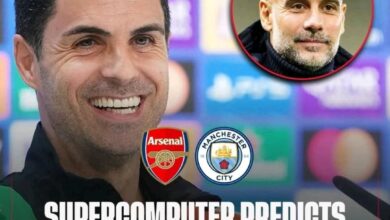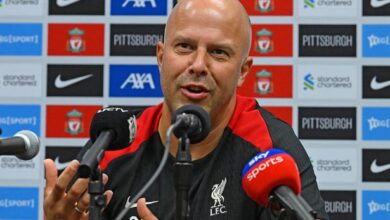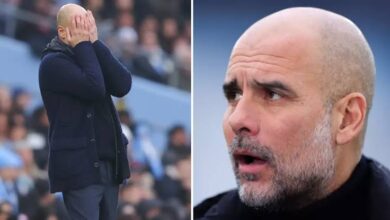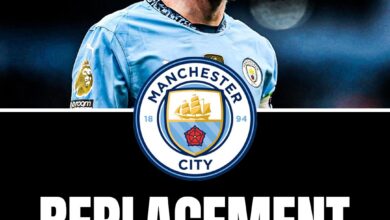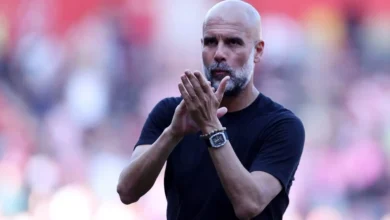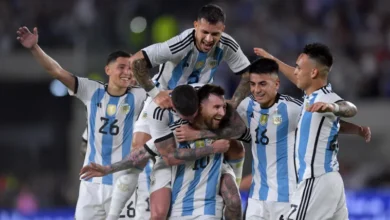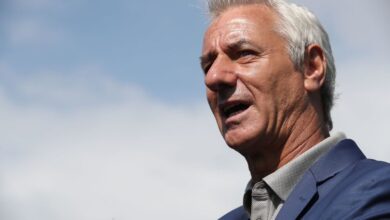Benjamin Sesko: The Future of Arsenal’s Attack

Arsenal Football Club finds itself at a pivotal juncture in the summer transfer window of 2025, with sporting director Andrea Berta orchestrating what could be one of the most significant squad overhauls in recent memory. The North London giants have already begun the process of reshaping their roster, confirming several departures while simultaneously pursuing ambitious acquisitions that could propel them to new heights in the upcoming 2025/26 season.
The Gunners’ approach to this transfer window reflects a mature understanding of squad development, balancing the need for immediate impact players with long-term strategic planning. Under the guidance of manager Mikel Arteta and the tactical acumen of Andrea Berta, Arsenal is positioning itself not just for short-term success, but for sustained excellence over multiple seasons.
The summer began with Arsenal making decisive moves to streamline their squad, addressing areas where change was necessary. The departure of Nuno Tavares to Lazio, secured for approximately £4.2 million, represents more than just a simple transfer transaction. It signifies Arsenal’s commitment to maintaining a squad composition where every player serves a specific tactical purpose within Arteta’s system.
Tavares, despite his undeniable talent and attacking prowess from the left-back position, often struggled to find consistency in his defensive responsibilities. His departure opens up both financial resources and squad space for Arsenal to pursue alternatives that better align with their tactical philosophy. The Portuguese full-back’s move to Serie A provides him with an opportunity to continue his development in a league that may better suit his playing style, while Arsenal benefits from the transfer fee that can be reinvested in other areas of need.
The free transfer of Jorginho to Brazilian club Flamengo marks the end of an era for the experienced Italian midfielder. His departure, while anticipated given his advancing age and reduced playing time in recent seasons, removes a wealth of experience from the Arsenal dressing room. However, it also creates space in the midfield for younger, more dynamic options that can contribute over a longer period.
Perhaps most significantly, the expected departure of Kieran Tierney back to Celtic represents both an emotional and tactical shift for Arsenal. Tierney, once considered one of the Premier League’s most promising left-backs, has seen his career hampered by persistent injury concerns. His return to Celtic, where he initially made his mark in professional football, offers him the chance for regular playing time and a fresh start, while Arsenal can allocate resources toward a more reliable defensive option.
Central to Arsenal’s transfer strategy this summer is the situation surrounding Thomas Partey, whose contract expires at the end of June. The Ghanaian midfielder represents a fascinating case study in modern football’s approach to player retention and squad management. Despite his undeniable quality and the pivotal role he has played in Arsenal’s recent tactical evolution, questions surrounding his long-term fitness and age have created uncertainty about his future.
Mikel Arteta’s desire to retain Partey for at least one more season speaks to the midfielder’s continued importance within the team’s tactical framework. Partey’s ability to break up play, distribute the ball effectively, and provide defensive stability has been crucial to Arsenal’s recent success. His physical presence and experience in high-pressure situations make him an invaluable asset, particularly in crucial matches against top-tier opposition.
The ongoing negotiations between Partey’s representatives and Arsenal’s hierarchy reflect the complex nature of modern contract discussions. Financial considerations, playing time guarantees, and role clarity all factor into these deliberations. For Arsenal, retaining Partey represents continuity and tactical familiarity, allowing them to maintain their current system while gradually integrating new signings.
However, the uncertainty surrounding Partey’s future also underscores Arsenal’s need to plan for contingencies. Whether he signs a new contract or departs, the club must ensure they have adequate midfield depth and quality to maintain their competitive edge across multiple competitions.
The pursuit of Martin Zubimendi represents perhaps the most strategically significant move in Arsenal’s transfer plans for this window. The Real Sociedad midfielder, who recently showcased his abilities on the international stage by scoring for Spain in the Nations League final against Portugal, embodies the type of player Arsenal seeks to build their future around.
Zubimendi’s verbal agreement to join Arsenal, pending only a medical examination, represents a major coup for the North London club. His technical ability, tactical intelligence, and physical attributes make him an ideal fit for Arteta’s system. The 26-year-old’s experience in La Liga, combined with his international pedigree, provides Arsenal with a midfielder capable of operating at the highest level immediately upon arrival.
The €60 million release clause in Zubimendi’s contract, equivalent to approximately £51 million, represents significant investment but one that Arsenal believes will pay dividends over multiple seasons. The player’s age profile suggests he could serve as a cornerstone of the midfield for years to come, providing both immediate impact and long-term value.
The reported interest from Real Madrid adds an element of drama to the transfer saga, highlighting Zubimendi’s quality and the competitive nature of modern football transfers. Real Madrid’s late intervention attempts to hijack the deal demonstrate the high regard in which the midfielder is held across European football. However, Arsenal’s confidence in completing the transfer suggests they have built strong relationships with both the player and his representatives.
The timing of any announcement, potentially delayed until July for accounting purposes, reflects the increasingly sophisticated financial planning that characterizes modern football operations. This approach allows clubs to manage their financial fair play obligations while completing strategically important transfers.
Arsenal’s agreement to sign Kepa Arrizabalaga from Chelsea for £5 million represents a shrewd piece of business that addresses multiple needs within the squad. The Spanish goalkeeper’s arrival provides crucial depth behind David Raya while bringing Premier League experience and international pedigree to the Emirates Stadium.
Kepa’s career trajectory, from record-breaking signing to Chelsea’s backup goalkeeper, offers valuable lessons about resilience and adaptation in professional football. His willingness to accept a secondary role at Arsenal demonstrates maturity and a desire to contribute to team success rather than prioritizing individual recognition.
The relatively modest transfer fee for a goalkeeper of Kepa’s caliber reflects both Chelsea’s desire to move on and Arsenal’s negotiating acumen. For £5 million, Arsenal acquire a goalkeeper capable of stepping into the first team if required, while providing healthy competition that should elevate the performance of all goalkeepers in the squad.
Kepa’s technical ability with the ball at his feet aligns perfectly with Arsenal’s possession-based playing style. His distribution skills and comfort in playing out from the back make him an ideal fit for Arteta’s tactical system, where goalkeepers are expected to contribute significantly to the team’s build-up play.
Perhaps the most exciting and potentially transformative deal Arsenal could complete this week involves Benjamin Sesko, the Slovenian striker who has emerged as one of Europe’s most promising young forwards. The 22-year-old’s impressive record of 21 goals in 45 appearances for RB Leipzig last season has caught the attention of numerous top clubs, but Arsenal appears to be making the most significant advances in securing his signature.
Sesko represents the type of forward Arsenal has been seeking to complement their existing attacking options. His combination of height, pace, and technical ability provides a different dimension to Arsenal’s attack, offering tactical flexibility that could prove crucial in various match situations. The striker’s age profile aligns perfectly with Arsenal’s long-term planning, suggesting he could develop into one of the Premier League’s elite forwards over the coming seasons.
The consideration of Viktor Gyokeres as an alternative target demonstrates Arsenal’s thorough approach to transfer planning. However, their apparent focus on Sesko suggests they believe he offers superior potential for development and integration into their tactical system. The Slovenian’s experience in the Bundesliga provides him with exposure to high-intensity football that should ease his transition to the Premier League.
Sesko’s goal-scoring record, while impressive, tells only part of his story as a footballer. His ability to link play, create opportunities for teammates, and contribute to defensive phases makes him an ideal fit for Arteta’s demanding tactical system. Modern forwards are expected to contribute far beyond simply scoring goals, and Sesko’s all-around game suggests he can meet these expectations.
These four potential deals reflect Arsenal’s broader strategic vision for sustainable success in English and European football. The combination of experience (Kepa), proven quality (Zubimendi), and future potential (Sesko), alongside the careful management of existing assets (Partey), demonstrates a sophisticated approach to squad building.
Andrea Berta’s influence on Arsenal’s transfer strategy cannot be overstated. His experience in identifying and developing talent, combined with his understanding of European football markets, provides Arsenal with a significant advantage in pursuing their transfer targets. The sporting director’s ability to balance immediate needs with long-term planning reflects the type of strategic thinking necessary for sustained success at the highest level.
The financial implications of these potential transfers also deserve consideration. The combined investment in Zubimendi, Sesko, and Kepa would represent a significant commitment to squad improvement, but one that Arsenal appears prepared to make. The club’s improved financial position, driven by recent success and improved commercial arrangements, provides the foundation for such ambitious transfer activity.
The integration of these new signings into Arsenal’s existing tactical framework presents both opportunities and challenges for Mikel Arteta. Each player brings specific qualities that could enhance different aspects of Arsenal’s play, from Zubimendi’s midfield control to Sesko’s attacking threat.
The potential midfield partnership between Zubimendi and either Partey or other existing options could provide Arsenal with the balance and quality necessary to compete with the Premier League’s elite teams. Zubimendi’s ability to operate in various midfield roles offers tactical flexibility that could prove crucial in different match situations.
Sesko’s integration into Arsenal’s attack would likely require adjustments to existing patterns of play. His physical presence and direct running could provide Arsenal with a different attacking dimension, potentially making them less predictable and more difficult to defend against
The successful completion of these four deals would transform Arsenal’s squad profile and competitive prospects for the upcoming season. The combination of proven Premier League experience, international quality, and emerging talent creates a foundation for sustained success across multiple competitions.
The timing of these potential announcements and completions will be crucial for Arsenal’s pre-season preparations. Early completion of transfers allows for better integration during training camps and friendly matches, providing Arteta with more time to implement tactical adjustments and build team chemistry.
As Arsenal prepares for what could be a defining transfer window, the four deals identified by Andrea Berta represent more than simple player acquisitions. They embody a strategic vision for the club’s future, balancing immediate competitive needs with long-term sustainability and growth. The coming weeks will reveal whether Arsenal can successfully execute this ambitious transfer strategy and position themselves for success in the 2025/26 season and beyond.
The intersection of sporting ambition, financial capability, and strategic planning will ultimately determine whether these transfer pursuits result in the squad transformation Arsenal seeks. For the club’s supporters and stakeholders, the anticipation builds as each day brings the possibility of announcements that could reshape Arsenal’s competitive trajectory for years to come.






